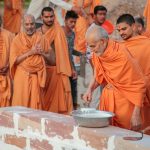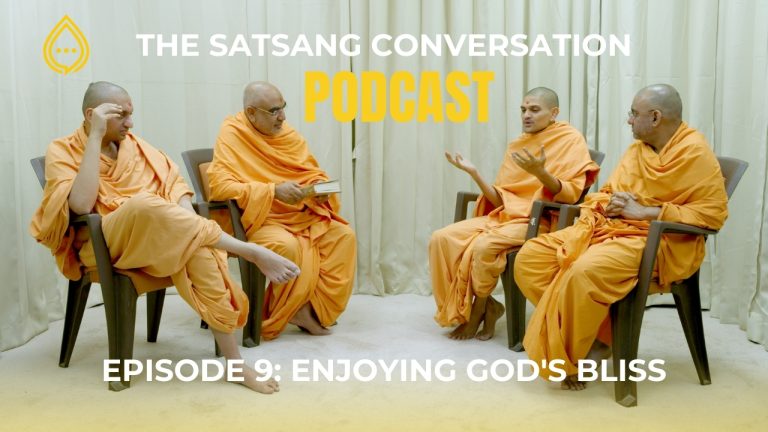In a recent episode of Satsang Conversations, the discussion took listeners on a deep and introspective journey through the teachings of Bhagwan Swaminarayan in Vachanamrut Gadhada Section 1, Number 16. Hosted at the serene BAPS Mandir in Houston, Texas, the episode featured a dialogue with Swami Bhaktivardhandas and other devotees, reflecting on the profound message of wisdom (Vivek) outlined in this Vachanamrut.
Understanding Wisdom: The Power of Self-Reflection
The conversation began with an exploration of how wisdom is defined in Vachanamrut Gadhada I-16. Bhagwan Swaminarayan explains that a true devotee, one who possesses wisdom, has the ability to distinguish between sat (truth) and asat (falsehood). Such a person not only identifies their own flaws but also makes a conscious effort to eradicate them.
The speakers emphasized how difficult this process of self-reflection can be. Human nature often leads individuals to focus on external circumstances, blaming others for their shortcomings rather than acknowledging their own imperfections. However, Bhagwan Swaminarayan teaches that recognizing one’s flaws is the first essential step toward spiritual growth. Without this realization, a person remains in a state of moh (delusion), unable to see the truth of their own imperfections.
One of the key takeaways from this discussion was the importance of moving beyond mere acknowledgment of flaws. The wise devotee not only recognizes their weaknesses but actively works to eliminate them. The Vachanamrut does not say that the devotee tries to eradicate their flaws—it states that they eradicate them. This implies a mindset of determination and unwavering commitment to personal transformation.
Rejecting Flaws in Others: A Path to a Pure Mind
The discussion then shifted to another characteristic of a wise devotee: the ability to reject the apparent flaws in others. Bhagwan Swaminarayan states that such a devotee does not dwell on the faults of fellow satsangis or santos, but rather focuses only on their virtues.
This concept, though simple in principle, is challenging in practice. It is human nature to notice and sometimes dwell on the shortcomings of others. However, as Yogiji Maharaj often emphasized, a devotee should strive to look only at their own flaws while seeing only virtues in others.
A powerful example was shared about Yogiji Maharaj himself. Even when a thief was caught red-handed stealing shoes, Yogiji Maharaj refused to believe the negative perception of the individual, instead stating, “Aato mukta chhe” (This person is liberated). Decades later, that same individual returned to the satsang, having been transformed by Yogiji Maharaj’s unwavering belief in his goodness.
Such an attitude of rejecting others’ faults requires deep internal discipline. The speakers discussed how people often engage in confirmation bias—subconsciously looking for evidence to support their negative opinions about others. Instead, Bhagwan Swaminarayan teaches devotees to actively reject those thoughts and replace them with an appreciation for virtues.
Recognizing God’s Perfection
Bhagwan Swaminarayan then extends this idea further, stating that a wise devotee never perceives flaws in God. This teaching underscores the idea that if one sees faults in fellow devotees, it can eventually lead to perceiving flaws in God Himself.
The conversation highlighted how unmet expectations often lead people to question or even blame Bhagwan for their struggles. When things do not go according to plan, it is easy to wonder why Bhagwan did not intervene in a way that seemed fair. However, Bhagwan Swaminarayan teaches that true wisdom lies in understanding that God is sarva karta—the doer of all things—and that every experience is ultimately for one’s own spiritual upliftment.
A striking example shared was that of Alaiya Khachar, a devoted follower of Bhagwan Swaminarayan. Despite his immense faith, his ego eventually led him to question Maharaj’s actions, causing his downfall. This serves as a reminder that unchecked ego can lead one to stray from the path of faith, ultimately leading to doubts about God’s perfection.
Trusting the Satpurush: The Gateway to Atmagnan
One of the most profound takeaways from Vachanamrut Gadhada I-16 is the idea that a wise devotee places absolute trust in the Satpurush (God-realized saint). Bhagwan Swaminarayan states that such a devotee accepts the words of the Sant as the highest truth (Param Satya) without doubt.
This principle is beautifully illustrated in the life of Bhagatji Maharaj, who displayed unwavering obedience to Gunatitanand Swami. Even when situations seemed counterintuitive—whether in terms of health, social norms, or personal well-being—Bhagatji Maharaj placed his faith in the Sant, believing that his words were absolute truth. This level of trust enabled him to transcend worldly limitations and attain spiritual realization.
The speakers also linked this teaching to the importance of following agna (spiritual commands). Bhagwan Swaminarayan states in the Vachanamrut that following the Satpurush’s agna is what allows a devotee to experience Atmagnan—the realization that they are the atma, distinct from the body and mind.
Detaching from Bondage and Negative Influences
Another essential teaching from this Vachanamrut is that a wise devotee actively shuns objects and associations that lead to spiritual bondage or deficiencies in Ekantik Dharma (the path of spiritual liberation).
Examples were shared of great devotees like Nishkulanand Swami, who once found himself momentarily drawn to a field of ripe chilies. Recognizing that such an attachment was unworthy of his spiritual pursuit, he punished his senses by eating them in excess, ensuring that he would never crave them again.
Similarly, a more contemporary example was that of a young boy named Akshar, who completely gave up watching television after Pramukh Swami Maharaj lovingly asked him to. Despite living in an era where television is a common form of entertainment, he remained committed to his niyam, even going so far as to listen to the news with his back turned to the screen when required for a school assignment.
Cultivating Positive Thoughts: The Mark of True Wisdom
Bhagwan Swaminarayan concludes this Vachanamrut by stating that a wise devotee actively cultivates positive thoughts while rejecting negative ones. The speakers reflected on how this teaching aligns with Mahant Swami Maharaj’s constant encouragement to see Bhagwan’s mahima (greatness) in every situation.
No matter the struggles one faces, the presence of Bhagwan and the Satpurush is far greater than any personal weakness. By continuously reinforcing this understanding, a devotee can develop resilience, positivity, and a deeper connection to Bhagwan.
Conclusion
The discussion on Vachanamrut Gadhada I-16 was a deep dive into the qualities of a truly wise devotee. By examining one’s own flaws, rejecting faults in others, seeing only Bhagwan’s perfection, trusting the Satpurush, detaching from negativity, and cultivating a positive outlook, one can develop true Vivek—the wisdom to navigate both spiritual and worldly life.
Vachanamrut Gadhada Section 1 – 16: https://www.anirdesh.com/vachanamrut/index.php?format=en&vachno=16
Vachanamrut Study Application: thesatsanglife.com/vachanamrut
Location: BAPS Shri Swaminarayan Mandir, Houston (https://maps.app.goo.gl/JUqU58EznRKt9iq16)














+ There are no comments
Add yours